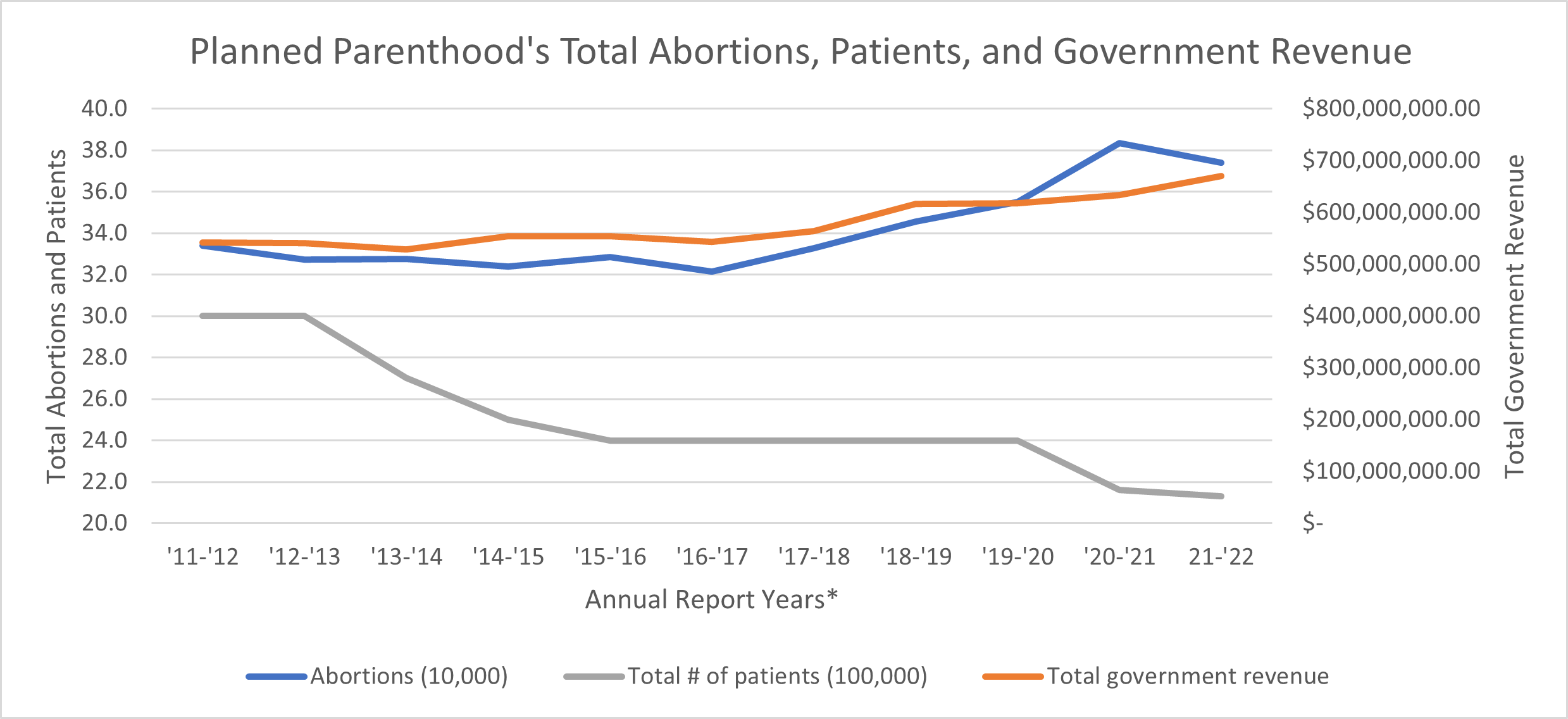Fact Sheet: Planned Parenthood’s 2021-22 Annual Report
Abortions and Non-Abortion Services: Change from Last Year and Long-Term Trends
- Planned Parenthood’s service data lags behind the rest of the information in the report – the 2021-22 report contains information on services provided in 2020-2021.[1]
- Planned Parenthood performed 374,155 abortions[2] in 2020-21 – down a little over 9,300 from the previous year, but over 3.4 million abortions[3] over the past 10 reports.
- The number of patients (2.13 million)[4] decreased by approximately 30,000 patients from the previous year.
- In 2020-21, abortions made up 97.2% of Planned Parenthood’s pregnancy resolution services, while prenatal services, miscarriage care, and adoption referrals accounted for only 1.6% (6,244), 0.7% (2,653) and 0.5% (1,803), respectively.[5]
- For every adoption referral in 2020-21, Planned Parenthood performed 208 abortions.[6] Over the past 10 annual reports, the ratio was approximately 130 abortions for every one adoption referral.[7]
- According to data from Planned Parenthood’s own annual reports[8], since 2010:
-
- Total services are down 17.1%.
- With changing practice guidelines,[9] total cancer screening and prevention services have dropped by 71%, including declines of 74% for breast exams and 70% for pap tests.
- Prenatal services are down 85% from their peak in 2009.
- Contraceptive services are down 36%.
Planned Parenthood’s Financials
- In its 2021-22 annual report, Planned Parenthood reported $1.9 billion in income[10] and over $2.3 billion in net assets[11] — an increase from the previous report.
-
- $694.9 million came from private contributions, up 20% from the previous report.[12]
- Taxpayer funding in the form of government grants, contracts, and Medicaid reimbursements hit $670.4 million, or almost $1.9 million per day[13]– an annual increase of $1 million from the previous year to make up 35% of Planned Parenthood’s overall revenue.[14]
- Planned Parenthood’s taxpayer funding has increased by nearly 37.5% since 2010.[15]
- However, taxpayer funding is reported by Planned Parenthood’s affiliates, whose information lags behind the national office and covers fiscal years ending in 2021.[16]
- Planned Parenthood’s excess of total revenue over total expenses is $204.7 million.[17] Last year Planned Parenthood reported an excess of total revenue over total expenses of $133.7 million.[18]

*The years on the graph denote the fiscal years that Planned Parenthood’s annual reports cover. As noted on pages 1 and 2, the service data and government funding data in those annual reports contain information on services provided for the year before the fiscal year.
[1] https://cdn.plannedparenthood.org/uploads/filer_public/25/ed/25ed2675-fbbc-453b-8b35-f8ddaa025b57/281222-ppfa-annualreport-c3-digital.pdf
[2] Planned Parenthood 2021-22 Annual Report, p. 29.
[3] Planned Parenthood annual reports, 2012-13 through 2021-22.
[4] Planned Parenthood 2021-22 Annual Report, p. 11.
[5] Planned Parenthood 2021-22 Annual Report, p. 29.
[6] Planned Parenthood 2021-22 Annual Report, p. 29.
[7] Planned Parenthood annual reports, 2012-13 through 2021-22.
[8] Ibid.
[9] See, e.g., “What Is Breast Cancer Screening?: Breast Cancer Screening Recommendations,” Centers for Disease Control and Prevention. https://www.cdc.gov/cancer/breast/basic_info/screening.htm (accessed May 12, 2023).
[10] Planned Parenthood 2021-22 Annual Report, p. 32.
[11] Planned Parenthood 2021-22 Annual Report, p. 30.
[12] Planned Parenthood 2020-21 Annual Report, p. 30.
[13] Planned Parenthood 2021-22 Annual Report, p. 32.
[14] Ibid.
[15] Planned Parenthood annual reports, 2009-10 and 2021-2022.
[16] Planned Parenthood 2021-22 Annual Report, p. 34.
[17] Planned Parenthood 2021-22 Annual Report, p. 38-39. See Total Revenue of $1,906.7 million and Total Expenses of $1,702 million.
[18] Planned Parenthood 2020-21 Annual Report, p. 30-31. See Total Revenue of $1,714.4 million and Total Expenses of $1,580.7 million.





























